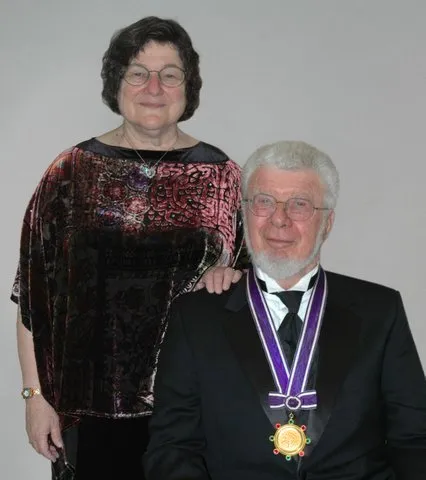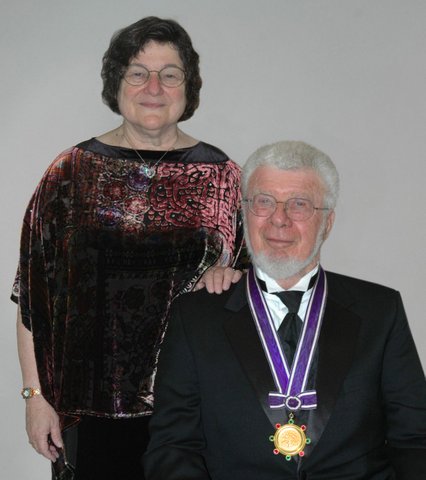
James Watson, Francis Crick, Linus Pauling and Rosalind Franklin are staple figures of biology textbooks today, but their names also appear frequently in the professional repertoires of two Stanford genetics professors, husband and wife Leonard “Len” and Leonore “Lee” Herzenberg.
“There’s a saying: ‘Standing on the shoulders of giants,’” said Lawrence Steinman, professor of neurology and chair of Stanford’s program in immunology. “[Len and Lee] may not physically look like giants, but they are the giants of immunology.”
And friendly, warm, welcoming giants they are. As lab members passed by Lee’s office, she called out to each one, whether passing along a memo, inviting them to dinner, calling them to join the ongoing conversation in her office or simply saying hello. Her office, too, evoked an amicable atmosphere with splashes of color, shelves of family pictures and assorted memorabilia.
The Herzenbergs’ dog, a Bichon Frise named Gigi, also spends her time in the lab, obediently lying next to Lee on an orange cushion on the ground. Len’s office is conveniently located right next to Lee’s, allowing for easy and convenient communication, a central element of their work together.
“We are a two-headed horse that mostly goes in the same direction,” Lee said. “We nourish the same body, and the two heads talk a lot.”
The pair met at Brooklyn College in 1952, when Len was a senior and Lee was a freshman. Lee needed an analytic geometry tutor, and a mutual friend introduced her to Len, who tutored high school students at the time. Their friendship blossomed into a relationship, and an engagement came soon thereafter. While their parents expressed concern about the marriage because of the pair’s youth and many remaining years of schooling, Len and Lee fully believed in the connection they shared and were determined to maintain it.
“From the time we started to go out, we knew we were engaged,” Lee said.
Len went on to graduate school at Caltech, which, at the time, boasted a biology department that included seven future Nobel Prize winners. There, he was exposed to an interdisciplinary research culture that the Herzenbergs maintain in their lab today.
To be closer to Len, Lee transferred from Brooklyn College to Pomona College. However, the science courses at Pomona paled in comparison to those at Caltech, and Lee soon began auditing graduate level classes there instead. While she could have enrolled as a student, Caltech did not accept women into its graduate programs–an early incidence of the gender discrimination Lee would face later in life. Still, Lee praises Caltech’s biology department for its support of women in her field and credits her teachers there with teaching her how to think about science.
Following his time at Caltech, Len worked for the Pasteur Institute and the National Institutes of Health before he was asked to join the biology department at Stanford. He accepted the offer, an especially fitting choice because Stanford was one of only a few schools that allowed couples to work together. Lee had already started pursuing her own scientific research interests.
It was at Stanford that Len developed the award-winning technique of fluorescence-activated cell sorting (FACS), which rapidly sorts cells based on fluorescence markers on their surfaces. Invented in the late 1960s, there are now over 30,000 FACS machines worldwide, and the technology has played a crucial role in the fields of immunology, cancer biology and regenerative medicine, among others. For the FACS technique and his lifelong contributions to science, Len received the Kyoto Prize, Japan’s equivalent of the Nobel, in 2006.
The Herzenbergs’ successes are largely a result of their teamwork and collaboration. There is never competition between them, as the two publish papers together and maintain jointly functioning laboratory groups at Stanford. With different temperaments and interests, their relationship is defined more by complementary aspects than similarities.
“Len is more into the science, and he loves to range freely across all sciences,” Lee said. “He finds a new area of science, brings in a fellow or a student and then he finds another area in two years. At one point, I told him, ‘If you bring me home one more baby, I’m going to go crazy.’”
On the other hand, Lee calls herself the “data person” and is more technically oriented. Her main focus is detailed work in the lab, such as statistical analysis, guidance of programmers and the development of new software.
Between them, knowledge is shared, and respect is mutual.
“Len taught me to be the scientist I am,” Lee said. “He taught me all of the science.”
For instance, Lee says that it is Len’s ability to make connections between a diverse range of fields that makes him stand out as a scientist, and he has inspired her to do the same.
“He can make connections that other people can’t, and he taught me how to do this,” she said.
Hearing this, Len smiled and credited Lee’s innate aptitude.
A close working environment has also had clear benefits for the couple.
“When two people have separate careers, they have to manage their own priorities, but they don’t have intimate knowledge of the priorities,” Lee said. “For us, that knowledge has always been common between us.”
For instance, if one of their children felt homesick or needed to be picked up, their knowledge of each other’s duties at work allowed them to determine who could most conveniently leave to take care of the issue, they said.
Their lifestyle preferences are also complementary, as Len is a “morning person” and Lee tends to work from midnight until 3 or 4 a.m. In the early 1970s, when their children were young, Len prepared breakfast for the children, as Lee was seldom awake in the morning.
“Len would often [take care of the children], and he didn’t necessarily like other people to know this,” Lee said. “But when it became something okay [for men to do], he made sure to tell people he had always made his kids breakfast.”
This mutual support for one another took a more political turn early in Lee’s career as a woman in a scientific field. Lee, unafraid to speak her mind, would often join her male colleagues in discussions and seminars, winning the acceptance of some and the disdain of others. Len, however, was supportive throughout, respecting Lee for her ideas and contributions.
“He didn’t treat a woman like she had to stay home,” Lee said. “I respected him, and he…respected me.”
In addition to Len’s support, Lee has also had a number of female role models who encouraged her to pursue her career. One such figure was Linus Pauling’s wife, Helen Pauling, who told Lee to be persistent.
“[Helen] was never really allowed to develop her career, so she told me to keep at it,” Lee said. “She told me, ‘Don’t let them keep you down.’ She made a very strong impression.”
Sixty years after their first meeting, Lee and Len Herzenberg continue to share their work and their lives. Their afternoons are spent in the lab, still collaborating with their peers and colleagues and working as a team to advance the threshold of scientific knowledge.
“We’ve never really changed,” Lee said. “We do everything together.”
